

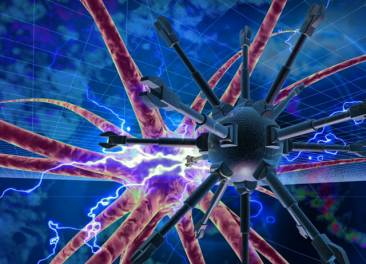

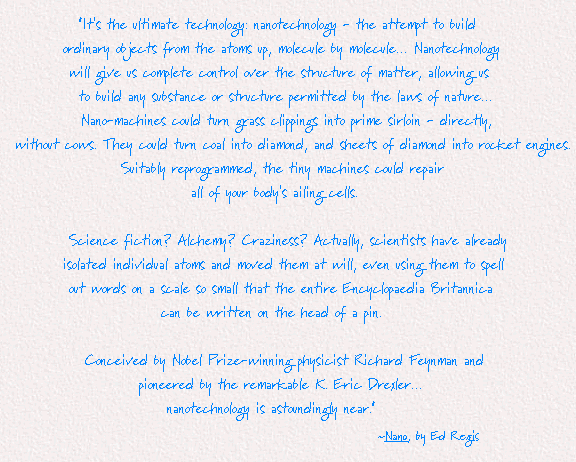
Every few decades or so within the past few centuries, the great
scientists of the era come together and find a new focus, devoting their lives
to it. Ultimately, they come up with theories, principles, and mechanical
structures that serve to change society as it exists. Though much of the changes
instituted by past sciences have been largely limited to intellectuals, the more
recent past scientific revolutions have led to incredible inventions that make
life astoundingly easier for the ordinary person, from the toaster to the
refrigerator to the automobile to the personal computer. With each new
generation comes a better understanding of the science behind it, and each new
generation seems to improve the past generation of technology, making it
smaller, more efficient, and less expensive.
As we enter the twenty-first century, we are on the edge of another
scientific revolution – yet few realize it. Even fewer realize the potential
this new science can have in changing our lives. Over the past forty or so
years, the best physicists, engineers, and professors have been toiling away,
trying to make strides in a field conceived by Richard Feynman back in 1959:
nanotechnology. Though Feynman’s original audience thought his ideas were
generated merely as jokes, they soon realized that he was serious. Forty years
later, scientists realize he couldn’t have been more serious.
Nanotechnology, the science of building anything and everything from the
atomic level up and thus on a miniature scale, is burgeoning into success. There
are already many success stories of nanotechnology: the first molecular motor, a
bridge that links strands of DNA, a material that can be used for military
uniforms that can vacillate between being waterproof and water-repellent – the
list goes on. There are countless prototypes for nanobots, assemblers, and other
technology that would be so small that it could develop into an army of
producers – all within a simple blood cell.
Quite simply, the advent of successful nanotechnology can potentially
revolutionize the way humans live, be it for better or for worse. The only thing
stopping its success is the lack of instruments that are small enough. Once the
tools are created, we will step out into a new frontier, one only dreamed of by
the most outrageous science fiction writers, one that will virtually change who
we are as human beings.
When people think of nanotechnology, they typically think of futuristic
gadgets that are years away from technical realization. However, in this view,
they fail to realize that
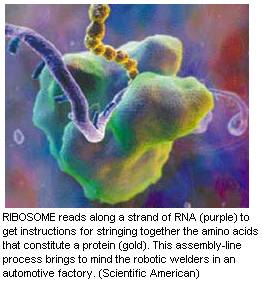 nanotechnology
in its most perfect state has in fact existed for millions of years.
Nanotechnology in its primary origins exists within the confines of the human
body – in the form of ribosomes. These cellular structures already do
everything that nanotechnology in the application of the human body will
eventually be designed to do by machine. Ribosomes are known as the
“factories” of the cells – they produce incredibly precise protein
molecules that are based on DNA blueprints and thus create the models for
humans. This control over the functions of the human body from the molecular
level is what the advent of nanotechnology hopes to achieve.
nanotechnology
in its most perfect state has in fact existed for millions of years.
Nanotechnology in its primary origins exists within the confines of the human
body – in the form of ribosomes. These cellular structures already do
everything that nanotechnology in the application of the human body will
eventually be designed to do by machine. Ribosomes are known as the
“factories” of the cells – they produce incredibly precise protein
molecules that are based on DNA blueprints and thus create the models for
humans. This control over the functions of the human body from the molecular
level is what the advent of nanotechnology hopes to achieve.
Modern nanotechnology first arose in 1959, when renowned physicist
Richard Feynman gave a lecture entitled, “There’s Plenty of Room at the
Bottom” at the annual meeting of the American Physical Society at the
California Institute of Technology. In this talk, Feynman introduced the concept
of building things atom by atom. According to the laws of physics, he said,
there was nothing prohibiting this: “The principles of physics, as far as I
can see, do not speak against the possibility of maneuvering things atom by
atom.” With these words, Feynman launched an extraordinary field of
technological research that expanded quickly with the modern expansion of
computer technology.
Though his audience initially thought Feynman was joking when he spoke of
writing the entire Encyclopaedia
Britannica on the head of a pin, they
soon realized he was serious. The
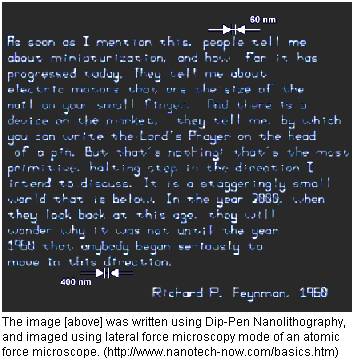 twenty-four
volumes of the Encyclopaedia
cover about the dimension of half a
football field, so to fit on the head of the pin, they would have to be shrunk
about 25,000 times – simple, said Feynman. At the size they would be printed,
each letter would be about ten atoms wide – plenty of room for maneuvering.
Feynman continued talking about conversions until he said that one could fit all
the words of all the books in the world on a few normal sized pieces of paper
– then told his audience that this was only a “primitive step” – for
words only exist in two dimensions. Since the head of a pin is domed,
information could be stored within the pin. All the information in all the books
could be fit into a space even smaller than the head of a pin – about the size
of the smallest particle of dust visible to the naked human eye. “So there is plenty
of room at the bottom! Don’t tell
me about microfilm!” exclaimed Feynman.
twenty-four
volumes of the Encyclopaedia
cover about the dimension of half a
football field, so to fit on the head of the pin, they would have to be shrunk
about 25,000 times – simple, said Feynman. At the size they would be printed,
each letter would be about ten atoms wide – plenty of room for maneuvering.
Feynman continued talking about conversions until he said that one could fit all
the words of all the books in the world on a few normal sized pieces of paper
– then told his audience that this was only a “primitive step” – for
words only exist in two dimensions. Since the head of a pin is domed,
information could be stored within the pin. All the information in all the books
could be fit into a space even smaller than the head of a pin – about the size
of the smallest particle of dust visible to the naked human eye. “So there is plenty
of room at the bottom! Don’t tell
me about microfilm!” exclaimed Feynman.
Feynman went on to remind his audience that tasks such as this had
already been done in nature – on DNA. From there, he posed his omnipotent
question: if nature can reduce
information to mere atoms, why can’t humans? Why couldn’t humans work with
atoms, the building blocks of creation – the “bottom” he was referring to
with the title of his speech? Finally, he was at the point where he could
explain the purpose of all this: machines so tiny that they could manipulate
individual atoms, controlled from the outside by humans, that could assemble
anything, that could be used to create countless factories, an atomic-scale
mass-production line that could create anything: computers, machines, lathes, or
dog houses. He offered a prize of one thousand dollars to the “first person to
take the information on the page of a book and put it on an area 1/25,000
smaller in linear scale in such a manner that it can be read by an electron
microscope,” and another prize to the first to make an operating electric
motor able to be controlled from the outside but confined to a 1/64 inch cube.
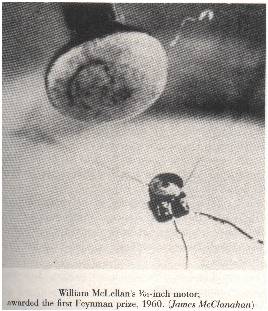 The first prize claimed was by William H. McLellan, who read Feynman’s
speech when it was published two months later in Caltech’s journal Engineering
and Science. He used number 56 wire
(half a thousandth of an inch in diameter, with insulation) to use in
galvanometers, and then wound the wire around four tiny iron pins which formed
the corners of a square base. A tiny magnetized disk was attached to a tiny
metal shaft, and set within the four pins. His theory was that the alternating
current sent through the coiled wires would prompt the disk to turn, provoked by
the magnetic field thus created. (The queer thing about McLellan’s motor was
that it was so tiny, the whirring of the motor didn’t even create enough
energy to make any sound, so it was completely silent while on.) After reaching
success, he brought the motor to Feynman, who had, of course, already witnessed
quite a few bogus inventions. McLellan later received a check from Feynman for
one thousand dollars. In reality, Feynman was a bit disappointed with the motor,
for he was hoping for new technology – perhaps for someone to grow a coil –
to have someone literally build it atom by atom.
The first prize claimed was by William H. McLellan, who read Feynman’s
speech when it was published two months later in Caltech’s journal Engineering
and Science. He used number 56 wire
(half a thousandth of an inch in diameter, with insulation) to use in
galvanometers, and then wound the wire around four tiny iron pins which formed
the corners of a square base. A tiny magnetized disk was attached to a tiny
metal shaft, and set within the four pins. His theory was that the alternating
current sent through the coiled wires would prompt the disk to turn, provoked by
the magnetic field thus created. (The queer thing about McLellan’s motor was
that it was so tiny, the whirring of the motor didn’t even create enough
energy to make any sound, so it was completely silent while on.) After reaching
success, he brought the motor to Feynman, who had, of course, already witnessed
quite a few bogus inventions. McLellan later received a check from Feynman for
one thousand dollars. In reality, Feynman was a bit disappointed with the motor,
for he was hoping for new technology – perhaps for someone to grow a coil –
to have someone literally build it atom by atom.
In the late 1970s, K. Eric Drexler published a book detailing his
independent theory of genetic engineering. The book, Engines of Creation,
is now considered a cornerstone of all nanotechnological research. In this book,
he uses the term ‘nanotechnology,’ which was first coined by Norio
Taniguchi, a professor at the University of Tokyo. However, Drexler’s referral
to nanotechnology is more the specific type of nanotechnology known as molecular
nanotechnology (MNT). In his book, he brought up the idea of “assemblers,”
components of systems built on the nano scale to do work on this scale, which
are typically expected to be capable of self-assembly. It is believed that if an
assembler were perfected, the only limitation to the realization of lofty
nanotechnological feats is the imagination. One scientist even goes so far as to
call it “the Holy Grail of nanotechnology.”[1] Though Drexler has a clear
idea of what the assembler should and could be, no scientists have been able to
actually construct one yet, as there are no tools in existence to carry out such
a task.
Feynman’s second prize was claimed in November 1985, by a man named Tom
Newman, a Stanford grad. Using a computer program that would control an
electron-beam fabrication tool as it wrote, and possessing a 25,000-transistor
chip, Newman was able to write out the first page of Charles Dickens’ book A Tale of Two Cities
– a personal favorite. He did this in a mere sixty seconds. Newman won
Feynman’s second prize, which came in the mail soon after with a letter
expressing Feynman’s joy at Newman’s work.
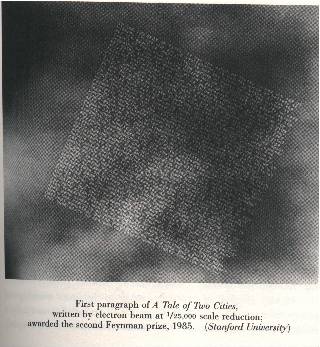 Because of its advanced technological components, nanotechnology is
largely a modern science, and is not possessor of a rich historical background
as are other branches of science. The majority of major nanotechnological
developments have taken place in the last ten years, for it is only during this
period that we have actually had the technology advanced enough to research and
develop nanotechnology. At this point, it is largely a research science. In
1995, White House science advisor Jack Gibbons realized the economic power of
nanotechnology and urged extensive research into the field, and the next year,
in 1996, Richard Smalley, Robert Curl, and Harold Kroto shared a Nobel prize for
finding supercarbon fullerenes, also known as buckyballs. (Buckyballs are
single-walled nanotubes that are distinguished from commonly defective
multi-walled nanotubes by their rigidly defined structure of molecules of pure
carbon.)
Because of its advanced technological components, nanotechnology is
largely a modern science, and is not possessor of a rich historical background
as are other branches of science. The majority of major nanotechnological
developments have taken place in the last ten years, for it is only during this
period that we have actually had the technology advanced enough to research and
develop nanotechnology. At this point, it is largely a research science. In
1995, White House science advisor Jack Gibbons realized the economic power of
nanotechnology and urged extensive research into the field, and the next year,
in 1996, Richard Smalley, Robert Curl, and Harold Kroto shared a Nobel prize for
finding supercarbon fullerenes, also known as buckyballs. (Buckyballs are
single-walled nanotubes that are distinguished from commonly defective
multi-walled nanotubes by their rigidly defined structure of molecules of pure
carbon.)
Nadrian
Seeman developed the first DNA based nanomechanical device at New York
University in 1997. He was able to create a cube and a truncated octahedron from
DNA by attaching the sticky ends of DNA to branched junctions which allow for
the construction of stick figures. This technology could eventually be used to
develop a biochip
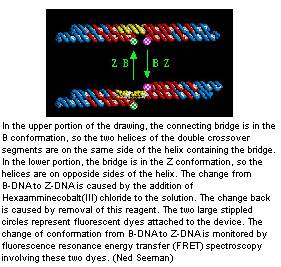 computer
on the nanoscale and a mechanism for synthesizing periodic matter on this scale.
His nanomechanical device utilizes the rigid structure of the antiparallel
double crossover molecule and the B-Z transition of DNA. He and his team created
a bridge between two double crossover molecules that allows for the conversion
of B-DNA to Z-DNA.
computer
on the nanoscale and a mechanism for synthesizing periodic matter on this scale.
His nanomechanical device utilizes the rigid structure of the antiparallel
double crossover molecule and the B-Z transition of DNA. He and his team created
a bridge between two double crossover molecules that allows for the conversion
of B-DNA to Z-DNA.
In 1999, Cees 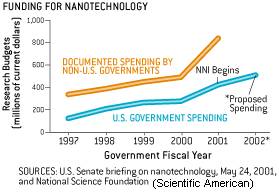 Dekker
designed the first carbon-nanotube transistor while at the Delft University of
Technology, and in 2000, the United States launched the National Nanotechnology
Initiative program under former president Bill Clinton, which invested $270
million to be used in the research and development of nanoscale science. Soon
after, Carlo Montemagno created, with a team of scientists at Cornell
University, the first nanomachine – a motor with a propeller. This, the first
major realization of nanotechnology as an application and a reality, was only
the beginning: in 2001, IBM, among others, created molecular-logic circuits
entirely from nanotubes, one of the major steps toward carbon chips, and in
2002, NASA’s Ames Center built a latticed nanostructure from modified
microbial proteins.
Dekker
designed the first carbon-nanotube transistor while at the Delft University of
Technology, and in 2000, the United States launched the National Nanotechnology
Initiative program under former president Bill Clinton, which invested $270
million to be used in the research and development of nanoscale science. Soon
after, Carlo Montemagno created, with a team of scientists at Cornell
University, the first nanomachine – a motor with a propeller. This, the first
major realization of nanotechnology as an application and a reality, was only
the beginning: in 2001, IBM, among others, created molecular-logic circuits
entirely from nanotubes, one of the major steps toward carbon chips, and in
2002, NASA’s Ames Center built a latticed nanostructure from modified
microbial proteins.
Nanotechnology is no longer
merely the science of the future: it is a reality to the hundreds of scientists
working to achieve incredible goals every day. As we slowly begin to unravel the
mysteries of this miniature science, we are realizing that it can both exceed
our expectations and bring undesired consequences that could be devastating.
Nanotechnology
is defined largely by Richard Feynman’s idea from 1959 that structures can
indeed be built from the atomic level up. It is, quite simply, the overarching
concept of building and manipulating structures at this scale in order to
achieve a variety of goals – everything from nanobots that would destroy
cancerous cells to filtration systems to clean up the atmosphere to elevators
reaching into space. It relies on the theory that control from the atomic level
is more effective: it is better, faster, stronger, and cheaper than present
technologies.
The
founding principle of nanotechnology is its size, and as such, it is important
to know just how small this technology is. One nanometer is one-billionth the
size of one meter. It is roughly the width of six bonded carbon atoms, of which
40,000 would approximate the width of an average human hair. Anywhere from three
to five atoms would constitute in width the length of one nanometer. One red
blood cell is about 7,000 nanometers (nm) in diameter, and 2,000 nm in height; a
virus is about 100 nm around; a Buckyball (created in 1996) is exactly one
nanometer; and a hydrogen atom, the smallest of the atoms, is 0.1 nm in
diameter.
There are several different types of nanotechnology, each with their own
specific classification. The first type is non-organic nanotechnology, which is
largely composed of the dreams of the technology fanatics. This type of
nanotechnology centers mainly around the nanobot: a tiny robot that is designed
to rebuild atoms and molecules on the site within the structure in which they
are found. While there is some intriguing research being done to accomplish
feats in this field, it is still more or less a branch of science fiction.
There
is then organic nanotechnology – the nanotechnology of the human body’s
ribosomes. Many believe that if scientists are able to custom design the
molecules and DNA codes that the ribosomes produce, it should be simple to
produce custom-made molecules that fulfill any and every desire one might have
for a molecule. During the past decade, there has actually been a project to
create gasoline style fuel through an organic factory, a process very similar to
that of the natural workings of ribosomes. Along these same lines, there are
many scientists who think that the next generation of computers – presumably
created on the nano scale – will be grown, not built. They would thus
originate from already existing structures, just as the molecules that create
the human body do.
The type of nanotechnology that is presently being most actively and
realistically pursued is the branch of structural nanotechnology: the logical
extension of miniaturization. Though there have been but a few devices produced
on an actual nano scale, smaller and smaller components to a variety of things
are being made, including molecular motors and switches. These are so small that
optical microscopes cannot detect them – tunneling electron microscopes are
needed to visualize them. This type of nanotechnology also applies to the next
generation of computers, possibly organically grown. These computers would be
the size of bacteria with the same capacity as today’s computers, or
supercomputers the size of sugar cubes, with the power of a billion modern
laptop computers, or even a computer that is the same size as a modern desktop,
but possessing the power of up to a trillion modern computers.
The final two mainstream classifications of nanotechnology are volatile
and non-volatile nanotechnology. Non-organic, organic, and structural
nanotechnology are all non-volatile, meaning they need precise programs which
dictate their functions. The ultimate goal, however, of nanotechnology, is to
create volatile mechanisms, which would function entirely on their own, adapting
to new situations and rewriting their programs as necessary to fit the
circumstances, the ultimate intelligence. If developed, this sort of technology
would be an incredible asset in the human body and upon the military
battleground, but could be also be highly dangerous if it didn’t function
correctly or got into the hands of an enemy.
There are myriad uses for nanotechnology, from saving lives to expanding
the universe. Most people researching the field have different motivations for
their work, but all share a common tie: they are all fueled by a desire to enter
a new phase of technology, and they all realize the changes that would take
place in our world if we were able to successfully build a proper assembler. We
would be able to attack diseases like cancer and AIDS, and other viruses and
pathogens; we could fit billions of times more information and production into
our world; we could even leave our world through nano-elevators or find new
areas of space by sending microscopic shuttles across the universe.
Ultimately, nanotechnology won’t be as hard to produce once the
assembler is created, for once this has been created, scientists can work with
nanomaterials just as they would with regular sized materials. Granted, they
need to figure out how to shrink every thing else, but we see technology
shrinking before our own eyes every day – computers, stereos, motors, computer
chips and storage – all are getting smaller, cheaper, and more efficient,
which is the aim of nanotechnology. The more advanced nanotechnology, like the
materials that morph, are thus understandably more unrealistic, since the
manufacture of those requires more than simply finding an assembler: they also
involve determine how to create the so-called “smart materials” which can
change their composition to fit various circumstances. Nanobots, used to move
within the body to attack pathogens, will be a mixture of simple and complex
once the assembler is created. Though the nanobots would be able to be produced
just as robots now are created, there is currently no way to destroy certain
viral cells. Scientists are thus dually working on methods of attacking the
cells once they have the technology to reach them.
The experimentation and research on nanotechnology that is currently
being done generally falls into two categories: “wet” nanotechnology, and
“dry” nanotechnology. Wet nanotechnology is nanotechnology that has to do
with biology and genetics, which basically translates into nanotechnology for
medical uses, of which the most notable is nanobots, or nanites. Nanobots are,
in simple terms, robots that would be used at the atomic and molecular level,
that will, as Drexler once said, “allow us to build almost anything that the
laws of nature allow to exist.” The only thing stopping us at this point from
designing nanobots is the lack of a viable assembler to build the robots;
however, the robots have been fully designed. Designs for nanobots are largely
computer assisted, using programs like CAD – certain people have been able to
get their designs specific to the atomic bonds.
Ralph
Merkle of the Xerox Palo Alto Research Center has actually already designed an
assembler and the components needed to build it, but this is easier said then
done – it is clearly very difficult to work with materials as small as these.
There are many benefits to using the computer to design the technology, however,
the most prominent of which is the fact that there is no test required, as the
computer can test the technology. This significantly decreases the research and
development cost of this specific technology. He cites two important properties
that are necessary to the development of the nanobot technology: positional
control, meaning that they will be able to both be controlled by humans and
larger computers, and each other, and the ability to self-replicate, which is
essential as they are expensive to produce, yet many are needed to work
effectively. The potential for nanobots is great, as they can eventually be
implemented to work like factories, with assemblers to sort them and transport
them to a tiny molecular arm, which would then organize them and build more –
a process that would be just like the robotic welders of today’s factories.
As
nanobots are more or less forms of advanced computers, they are thus controlled
by mechanical computers. K. Eric Drexler has created a prototype for the logic
gate of a mechanical computer, which provides the output of a machine based on
an input. Like most computers, the rods use zeros and ones as denoted by clamped
and unclamped rods. Any change in voltage in the electronic computer translates
to movement of a rod, which
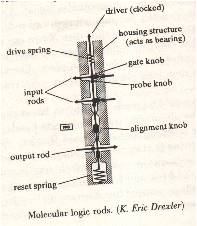 translates
into a signal. Molecular logic gates would be placed between the rods, creating
junctions that can block the movement of other rods, which forms the foundation
for logic circuits, memory cells, and read-write heads. These rods would be 44
atoms long and made of carbyne, which consists of linear chains of carbon atoms
linked by alternating single and triple bonds, making it strong and stiff, but
still only one atom thick. Each rod would have a housing sector that allows it
to move back and forth, transmitting various signals, but they would be
prevented from going beyond a certain point by molecular bumps called knobs.
This form of transmission would tell the mechanical device what to do and how to
do it, just a signals today tell a computer what functions to carry out.
translates
into a signal. Molecular logic gates would be placed between the rods, creating
junctions that can block the movement of other rods, which forms the foundation
for logic circuits, memory cells, and read-write heads. These rods would be 44
atoms long and made of carbyne, which consists of linear chains of carbon atoms
linked by alternating single and triple bonds, making it strong and stiff, but
still only one atom thick. Each rod would have a housing sector that allows it
to move back and forth, transmitting various signals, but they would be
prevented from going beyond a certain point by molecular bumps called knobs.
This form of transmission would tell the mechanical device what to do and how to
do it, just a signals today tell a computer what functions to carry out.
Nanobots
have the potential to do extraordinary cleanup work in both the environment and
the human body. One of the main benefits of nanotechnology is its environmental
efficiency: because nanotechnologies are literally built from the atomic level
upwards, there would be no waste products to cause pollution or destroy the
biosphere by taking too much from it. The production of nanotechnology is much
less selective, as well, since any raw material (like dirt or grass) could be
used for the construction of a nanotechnology – giving us a use for all the
garbage we have accumulated on this planet over the years. Additionally,
nanomachines would be efficient at recycling, because they can both construct
and deconstruct at the atomic level. Aside from being more environmentally
friendly with new production, nanomachines would also be able to reverse some of
the destruction we have wreaked on the environment in the past by purifying the
air, or by cleaning polluting machines simply by reorganizing their atoms.
Carbon in the atmosphere could be removed, and then be used to build houses for
an inordinate amount of people that would be both strong and lightweight –
homes could be built for ten billion people, only using about five percent of
the carbon left in the atmosphere from the aftermath of the Industrial
Revolution.
Not
only would we be able to repair the world we live in with nanotechnology, we
would also be able to repair our bodies by inserting nano-computers into living
cells, which could then watch for invading organisms and instantly destroy them
using assemblers. Viruses could also be removed by simply removing the
information in the DNA structures of the host organism, and cancer cells could
be destroyed. Plaques in the arteries and heart could be cleaned using
nanomachines, and the span of the human life would be extended with all these
killers eradicated from our bodies. Over a billion nanobots would fit into one
single drop of human blood.
The
research to create the first molecular motor was begun in 1997 by a group of
scientists (H. Noji, R. Yasuda, M. Yosida, and K. Kinosita, Jr.) who were able
to show that a subunit of the membrane protein F1-ATPase rotated in
response to the synthesis of ATP. This was amazingly close to a molecular rotary
motor, and from there on was researched continually to turn this into a
successful nanomotor, a task completed in the year 2000 by a team led by Carlo
D. Montemagno at Cornell University. The F1-ATPase protein has a
rotational velocity of 17 rps, and a diameter of less than 12 nm, making it the
perfect choice
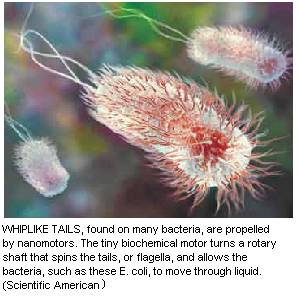 for
a nanomotor. Additionally, the F1-ATPase protein automatically
synthesizes using other functions of the body, thus “[opening] the door to the
potential of creating chemically powered nanomechanical devices… which may
provide the means for creating a transparent interface between the
organic/inorganic world.”[2]
for
a nanomotor. Additionally, the F1-ATPase protein automatically
synthesizes using other functions of the body, thus “[opening] the door to the
potential of creating chemically powered nanomechanical devices… which may
provide the means for creating a transparent interface between the
organic/inorganic world.”[2]
The
F1-ATPase biomolecular motor is produced by cellular physiology, yet
the scale of nanoelectromechanical technologies is much smaller than the size of
any cell. (Recall: it would take 7,000 nanometers to illustrate the length of
one red blood cell.) Thus, the scientists are working to be able to insert the
motor into a cell, which would be used to assemble the motor using the cell’s
physiology. Theoretically, the cell would also provide power for the motor in
the form of ATP, and would since it held the capacity to create new motors,
would replace them when the old ones ceased function.
Montemagno
and his team of scientists plan for the F1-ATPase motors to be used
to pump fluids and open and close valves in cellular devices, and also provide
mechanical drives for the next wave of nanotechnology. However, to reach the
point where they could create this motor, they had to overcome two goals. First,
they had to find an efficient way of manipulating and producing the motor
protein that would utilize the energy that the protein produces. They found this
in using an engineered form of a protein found in E.coli, the
PS3 F1-ATPase protein. This protein is used as a platform for the
scientists to use to engineer “chemical handles” on the protein, which will
later be used in the integration of the motor into the cellular technology. To
do so, they needed to find a way to actually attach the motors to the NEMS
(nano-electro-mechanical system). The solution was found in the development of
electron beam lithography using organic monolayers, a “surface chemistry
modification process that is compatible with both biological molecules and
semiconductor manufacturing processes.”[3] The precision of this
system is close to 15 nm, and was used to place “hands” on the NEMS that can
grab onto the handles of the NEMS to join the organic and inorganic parts of the
systems.
Although
the F1-ATPase motor protein is highly efficient and demonstrates
well, the scientists don’t actually know much about why the protein creates
the rotary motion that makes it so perfect for being a nanomotor. Thus, they do
not know how long the motor will last, or the impact of environmental variables
upon its function. Exploration of these quandaries is what is currently
involving Montemagno’s time, and the results of his efforts will be “a
hybrid organic and inorganic nanoscale system that both provides insight into
the basic mechanics of motor protein motion and establishes a technological
foundation for functionally integrating these molecules with manufactured
devices,”[4]
which, for the most part, have not yet been developed.
In
the fall of 2002, a team of scientists at Rensselaer Polytechnic Institute in
New York led by Pulickel Ajayan discovered a way to weld single-walled carbon
nanotubes, which are pure carbon cylinders that hold incredible electronic
properties – structures that provide an important foundation for the creation
of molecular circuits and nanotube networks. Along with colleagues from Germany,
Mexico, the United Kingdom, and Belgium, Ajayan used irradiation (ionizing
radiation) and heat to form welded junctions of nanotubes. Growth techniques had
previously been used to create multi-walled junctions of nanotubes, but
Ajayan’s discovery is the first time single-walled nanotubes have been spliced
mechanically.
The
bonds between the tubes are formed using inter-tube carbon-carbon bonds, which
are formed during the radiation and heating processes. These processes create
“just
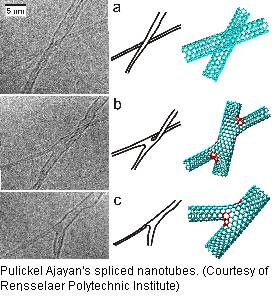 enough
defects for these bonds to form without damaging their electrical properties,”
says Ajayan. In order to view their work, the scientists used a special
high-voltage electron microscope that possesses the capacity to provide the
radiation heat that was used in the experiment. This microscope is one of few
worldwide and is located in Germany. Despite the success in linking the separate
nanotubes, Ajayan admits that he and his fellow scientists do not know how to
control the alignment of the tubes just yet, as it is very difficult to find
nanotubes that cross and touch. This relationship between tubes is what allows
them to be welded together, since the scientists do not yet know how to actually
move them about.
enough
defects for these bonds to form without damaging their electrical properties,”
says Ajayan. In order to view their work, the scientists used a special
high-voltage electron microscope that possesses the capacity to provide the
radiation heat that was used in the experiment. This microscope is one of few
worldwide and is located in Germany. Despite the success in linking the separate
nanotubes, Ajayan admits that he and his fellow scientists do not know how to
control the alignment of the tubes just yet, as it is very difficult to find
nanotubes that cross and touch. This relationship between tubes is what allows
them to be welded together, since the scientists do not yet know how to actually
move them about.
The
successes occurring more and more frequently in the field of nanotechnology have
begun to catch the interest of more than just scientists: they have caught the
attention of the United States Army. Recently, the Massachusetts Institute of
Technology became home to the Army-funded Institute for Soldier
Nanotechnologies, which holds labs in Cambridge. The primary focus of the dozen
or so MIT scientists involved with the Institute (known as ISN) is to build the
“military uniform of the future – not just light as silk and bulletproof,
but able to rapidly change at the molecular level to adapt to biological and
chemical threats.”[5]
Nanosensors in the uniform would be able to detect threats like anthrax or other
toxins, but would also be able to morph into a splint to assist an injury – or
even form an artificial muscle if needed. The sensors would be able to take
vital signs, which could be transmitted back to a medical team, or even monitor
the amount of nitric oxide in a soldier’s breath – a detective sign of
stress. Professor Ned Thomas, the head of the Institute, wants to create a
uniform that can detect lasers, like those used to focus a bullet – light
travels faster than a bullet.
While
Thomas and his researchers understand that these ideas are currently under the
classification of extremely far-fetched, they realize that they could, in time,
develop the technology to make them reality. He’s been able to prove the
potential for nanotechnological military equipment, too: last year he won a
competition with aircraft, tank, and carrier developers to receive $50 million
from the Army for experimentation. The body defense units he hopes to design,
known as BDUs, would contain the protection of five layers of protective gear
now, using materials that could deal with many specific threats as opposed to
just one.
Though
there have been very few developments in the material of Army uniforms since the
Vietnam War, there are many teams currently working on new materials. The
Army’s Soldier Systems Center outside of Boston works to improve uniforms, but
the teams at MIT are attempting to develop new ones. A team under engineer
Robert Langer has figured out how to make “smart surfaces” that can
alternately be water-repellent and water-absorbent by getting molecules to
“bend over” when given an “electrical tickle.” Alternate surfaces are
exposed with the action of the molecules, depending on if they are standing up
or leaning. However, it is difficult to develop a material that gives the
molecules the actual space to move about. The solution is to develop mushroom
shaped molecules which are thus spread out more so than the typical spherical
molecules. The caps of the mushroom are then cut off, and the result is a field
of standing molecules that are well spaced out. The space between the molecules
is only about 5 e -7 inches wide,
but in the world of nano, this is enormous. Scientists estimate that it will be
about ten years before the smart surfaces can actually be implemented in
uniforms.
Chemical
engineer Karen Gleason, however, has developed a method of waterproofing
uniforms that is ready to be implemented much sooner than this: she has come up
with a system of depositing nanolayers of Teflon onto fabric, adding only an
additional .001 pounds.
The
most interesting development in nanomaterials has been that of material
scientist Yoel Fink, who has come up with a nanomaterial composed of bags and
drawers full of coils made of flexible fibers, each of which consists of thirty
layers of alternating plastic and glass. Each layer of plastic or glass is 100
nm thick. These fibers can be woven into a soldier’s uniform, which would make
it identifiable in the dark – with special infrared vision goggles, soldiers
could differentiate their comrades from their enemies from up to thousands of
feet away. MIT won a grant last year for the production of this material from
the Army, and it can be developed now, though scientists are holding off, for
they do not know what to do if the material were to fall into enemy hands.
The
latest proposal for the use of nanotubes comes from Brad Edwards of Highlift
Systems, who proposes using the incredibly strong nanotubes to create a
carbon-nanotube space elevator 62,000 miles long and roughly three feet wide.
Yet because the walls would be made of the carbon nanotubes, they would be mere
millionths of a meter thick. This elevator would extend from the Earth to the
sky, allowing for space industries or tourists.
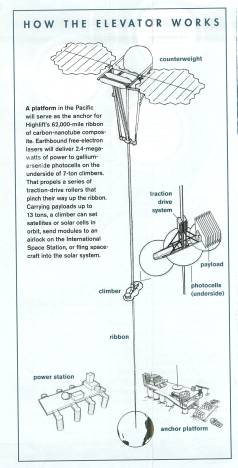 Edwards
plans to build the elevator using a nanotube composite of carbon atoms that is
four times stronger than steel (which has already been partially developed: one
form has been developed, just not as strong as Edwards would like). This
material would also be able to be used to build incredibly strong tennis
rackets, lighter and sturdier planes and cars, and much more durable bridges or
highways. The material for the space ribbon should be ready in a mere two to
three years.
Edwards
plans to build the elevator using a nanotube composite of carbon atoms that is
four times stronger than steel (which has already been partially developed: one
form has been developed, just not as strong as Edwards would like). This
material would also be able to be used to build incredibly strong tennis
rackets, lighter and sturdier planes and cars, and much more durable bridges or
highways. The material for the space ribbon should be ready in a mere two to
three years.
The base for the elevator will be similar to an offshore oil platform, and the site chosen is about 1,000 miles away from the Galapagos Islands in the eastern Pacific. This location is ideal, for it is 400 miles away from any airplane routes (planes crashing into it won’t be a problem), and in an area where there are few storms, thus avoiding lightning strikes. The construction of the elevator would begin with expendable rockets (which have already been developed) being shot into a low Earth orbit, where they would link together, creating a massive spacecraft that would then climb to 22,000 miles above the surface of the Earth and begin a geosynchronous orbit. Once in the orbit, the ribbon would be unraveled 40,000 more miles into space, while lowering a weighted ribbon down to the oceanic platform, guided by gravity – it should land within 100 miles of the platform, and can be found using GPS and beacons on the ribbon. It would then be attached to the platform. The other end of the ribbon would have a counterweight which would pull the ribbon taut through centripetal force.
At this point, massive seven-ton climbers would climb up the ribbon, carrying payloads up to twice their weight, powered by earthbound free-electron lasers, the same technology that is already used by Stanford in its linear accelerator. The lasers would be aimed at photocells within the climbers, which would power the climbers motors, bringing the elevator upwards. It would take about two weeks to reach the end of the ribbon, which is about a quarter of the way to the moon. The best part about this technology is that it eventually would cost as little as ten dollars per pound of cargo – as opposed to the current rate of $40,000 per pound to launch cargo into outer space. Edwards talks of his technology as being able to open up a new frontier inexpensively – as the railroad opened the American frontier in the 1800s. The elevator will cost over seven billion dollars to build, but Edwards has already received grants from NASA and other private investors.
Despite
the obvious gains that will come hand in hand with the success of
nanotechnology, there is also a plethora of risks associated with its success.
First, as with any technology, it would hardly be foolproof, and as such would
occasionally malfunction or make a replication or other type of error. If, for
instance, a nanobot destroyed the wrong type of cell, this would be deadly –
imagine if all of the sudden a tiny microbot began destroying all your white
blood cells! There would then be no immunity and the human body would be
crippled. Or, if the technology turned upon the object it was supposed to be
helping, it would instantly turn destructive.
If
the technologies being developed for military use were to fall into the wrong
hands, the consequences would be deadly as well. Aside from decreasing in worth
to one particular side that held an advantage, the developing side might also
now hold a disadvantage if and when an enemy was able to utilize the
opponent’s technology to create “better” technology. In the case of the
uniforms that are being developed for the Army, the uniforms make the soldiers
almost invincible, which is why they are so attractive to the U.S. Army. If,
however, they were stolen by an enemy, the U.S. would not only be defenseless,
but also unable to penetrate the enemy, and thus the effort poured into creating
the uniforms would not only have been a waste, but also a suicide. This concern
has already been identified by numerous Army scientists, and is the reason why
scientists such as Yoel Fink are holding off mass production of their
inventions.
Finally, on a more abstract level, there is a distinct fear of someone using nanotechnology to gain too much control. When stepping back from nanotechnology, one realizes that, if perfected, nanotechnology could create a perfect human – and also destroy any others unbelievably easily. Those involved with nanotechnological research are unsure of what to do with the technology if they find it, for they fear one person or group abusing the power coupled with the possession of advanced nanotechnology. Many stress the need for implicit trust between those involved in nanotechnology research projects to ensure they will not misuse the technology, both before and after technology is utilized in the commercial world.
The
most amazing thing about nanotechnology is that, as one man who was present to
hear Feynman’s 1959 speech once said, “you believe everything [the
scientists] say. It’s only after you leave the room that you realize you’ve
been had.”[6]
That is the truth of it. Every explanation of every nanotechnological instrument
or theory is spotlessly researched, developed, and explained, leaving no room
for mistake. One believes people like Brad Edwards and Ned Thomas, becoming
entranced by the idea of a revolutionized future, envisioning a future with such
accommodations at the hands of technology. It is only when one steps back to
view the larger picture that she realizes how preposterous it all seems – a
micro thin elevator reaching into the stars; a uniform that can change itself
for harmful conditions or form an artificial muscle – all the written words
from all the books in all the libraries in the world condensed onto the head of
one single pin! How can this be possible?
Yet
despite the unreal nature of these aspirations, we have seen the first steps
taking place that will eventually bring us to the point where they will become
realities. No, it will not happen in a few months, nor in a few years, most
likely. There is no doubt, however, that the edge of the new frontier does lie
in our future, where we will have billions of tiny robots crawling through our
blood, ridding our cells of any maligning bodies, where pollution and waste will
no longer be an issue, where we can travel to the far reaching territory of the
universe as easily as we might hop on a train into Boston. Nanotechnology is on
the verge of greatness, and will change the way humans live, be it to perfect
our world or to destroy it. All that hundreds of scientists know all over the
world is that the future of technology is calling their names, and they must
answer.
[1] The author of the article, “Nanotechnology Basics.”
[2] Quotations and idea: Montemagno’s abstract for the nanomotor, “Constructing Biological Motor Powered Nanomechanical Devices.”
[3]
Montemagno’s abstract.
[4] Montemagno’s abstract.
[5] From “Sci-Fi War Uniforms?” by Martha Brant.
[6] Bill Nierenberg, quoted in Nano, by Ed Regis.

This website clued me in to wet
nanotechnology versus dry nanotechnology. It also provided a bit of an
introduction to nanotechnology that mentioned Feynman’s lecture and
Drexler’s book. The information on Feynman merely served as a stepping stone
to what would be more extensive research. Also, some basic information about
Drexler’s ideas of the assemblers comes from this site.
Alfred, Chris and Chad Barb. “9th
Annual Utah High School Programming Contest – Take Home Problem –
Nanobots.” Viewed 4/12/03. <http://www.cs.utah.edu/outreach/contest/1999/description.html>
This page described a group of engineers who created a
nanobot, and discussed how it worked. I’m not sure of the relationship of the
high school to the nanobots, but I’m pretty sure high school students didn’t
design the nanobot…
Big Jim. “Great Hopes.” Viewed 4/12/03.
<http://www.his.com/~dionychus/nano/greathopes.html>
I think Big Jim is a college student doing some sort of
massive project on nanotechnology. He’s actually a little too into it,
I think… One of the flashing graphics on his page prompts the question,
“Will we be God?” [with nanotechnology]. This part of his site was useful
for the environmental uses for nanotechnology, and the uses within the human
body. I had to leave Big Jim when he started talking about using assemblers to
reach other planets and terraform them or build more human colonies… and
houses painting themselves. Yes, it’s possible, but he had no scientific
proof…
Big Jim. “Nanobots (And other things you can’t
see!)” Viewed 4/12/03. <http://www.his.com/~dionychus/nano/nanobots.html>
This is another of Big Jim’s
sites, about nanobots. It is a good description of the nanobots, and the
information about using computers to design assemblers was used in my paper.
Brant,
Martha. “Sci-Fi War Uniforms?” Newsweek. MSNBC Online. Viewed
2/24/03. <http://msnbc.com/news/872982.asp?0cl=cR>
I came across this article when I
was beginning my research while I was reading the news. It’s about the
nano-designed Army uniforms - an incredibly interesting concept, though rather
abstract. Aside from discussing the uniforms themselves and “smart
materials,” it also made me aware of the importance of identifying the risks
involved with nanotechnology.
(No author). “Foresight FAQ General
Nanotechnology Information.” Viewed 4/9/03. <http://www.foresight.org/NanoRev/FIFAQ1.html>
This is the Frequently Asked Questions section of
Foresight’s website, which is huge – it is an incredible resource for
nanotechnology information on the internet (I ran into it every time I did
research). These questions gave an overview of nanotechnology, including what it
is and how it is useful, along with reasons for developing it, and how it would
affect our lives. It also gave information about the risks associated with
nanotech. Foresight is one of the largest nanotechnology organizations, however,
so it was clearly in unanimous support of any and all nanotechnology.
Kelleher,
Kevin. “Starlight Express.” Wired. April 2003: pages 14 to 17.
This is the article in which I found about the space
elevator. It’s from Wired Magazine, which is a great resource – it documents
a lot of cool new technology, but it does so in an interesting and easy to
understand way. I think the best part about this article is you believe that
everything Edwards says he will do is entirely possible – he talks about it so
logically. Then you realize what he’s trying to do, and it’s astounding. The
graphic of the space elevator was a part of this article.
Montemagno, Carlo D. “Constructing Biological
Motor Powered Nanomechanical Devices.” [Abstract for a presentation.] Viewed
4/12/03. <http://www.foresight.org/Conferences/MNT6/Abstracts/Montemagno/>
Nothing like getting directly to the
primary source! This is Montemagno’s abstract from the Sixth Foresight
Conference on Molecular Nanotechnology where he talked about his nanomotor –
the first successfully created. Though it seems impossible to understand at
first due to the science he is describing, it actually is very clear once the
fear of it is abandoned. (The section about the F1-ATPase motor
largely parallels Montemagno’s abstract, as it is hard to reword such
science.)
(No author). “Nanotech Basics V1.0: Design
Concepts.” Viewed 4/9/03. <http://www.geocities.com/Teleran/societal/nanotech.html>
This was a nice, clear, easy to understand website that I
used to learn about the five basic types of nanotechnology: non-organic,
organic, structural, volatile, and non-volatile.
(No author). “Nanotechnology
Basics.” Viewed 4/9/03. <http://nanotech-now.com/basics.htm>
This site was great because it was funny, yet provided
good information. Most of the information about the relative size of the
nanometer is taken from this site. The nanolithography of Feynman’s speech
shown is from this resource. (Though I didn’t utilize this aspect of the site,
it is the home to most major recent nanotechnology developments.)
National Science and
Technology Council Committee on Technology – The Interagency Working Group on
Nanoscience, Engineering, and Technology. “Nanotechnology: Shaping the World
Atom By Atom.” Published December 1999: WTEC Hyper-Librarian.
First of all, leave it to the
government to create possibly the longest “author” ever. Second of all,
leave it to these same people to create the worst cover graphic ever with the
most ridiculous slogan: Shaping the World Atom By Atom. Aside from this,
however, this pamphlet is actually a good resource about nanotechnology. It was
published at the end of 1999, right after Bill Clinton passed the National
Nanotechnology Initiative. I didn’t take any actual information from this
pamphlet, but it provided an excellent backdrop to nanotechnology and proved the
national interest in it.
Regis, Ed. Nano.
Boston: Little, Brown, and Company, 1995.
I ran out to get this book because I wanted a summary of
Feynman’s speech and was unable to find one online – the site that had the
transcript of his lecture mentioned that there was a chapter in here that was a
good explanation of the speech. In going through it to get the information on
Feynman, I came across a lot of specific information that I felt entirely
obligated to put into my paper – more information about assemblers, along with
information on molecular logic rods and William McLellan’s 1960 motor. The diagrams
of the molecular logic rod and the photos of the 1960 motor and the A Tale of Two Cities engraving were located in this book. (There was also a great diagram
of the assembler, but it was too big to put into this paper in a way that it
would be decipherable.)
I found that the blurb on the inside
cover matched what I had written about and think about nanotechnology so
accurately, in the conveniently intriguing way of the book jacket, that I just
had to include it as the introduction to my paper. The quote at the beginning of
this essay is a bit of what it says.
Rensselaer Polytechnic Institute. “Press
Release: Nano-Welding Creates Tiny Junctions.” Viewed 2/28/03. <http://www.rpi.edu/web/News/press_releases/2002/ajayanwelding.html>
I was talking to my brother on the
phone and telling him about my paper back in February… he said one of his
professors had just done some cool thing with nanotechnology, and gave me this
article. It’s about Ajayan’s welding of the nanotubes.
The picture of Ajayan’s welding nanotubes comes from
this page. The high-quality image is located at: <http://www.rpi.edu/dept/NewsComm/sub/Pressimgs/nanojunction.jpg>
Rensselaer Polytechnic Institute Online Newspaper.
“News & Ideas: Nanowelding: Creating Tiny Junctions.” Viewed 2/28/03.
<http://www.rpi.edu/web/News/research/tip_sheets/jan_03/nanowelding.html>
This article is very similar to the Press Release about
Ajayan’s welding, but it mentioned the difficulty of finding nanotubes that
both cross and touch, which the other article didn’t.
Scientific American: Special
Issue – September 2001. “Nanotech: The Science of the Small Gets Down to
Business.”
Scientific American published a special issue in September
of 2001 focusing entirely on nanotechnology. It tells of everything important in
the field, and includes articles by Drexler and Richard Smalley. I read most of
it, but special attention was paid to “Little Big Science: Nanotechnology is
all the rage. But will it meet its ambitious goals? And what the heck is it?”
(by Gary Stix), along with “Machine-Phase Nanotechnology (by K. Eric Drexler),
and “The Once and Future Nanomachine” (by George M. Whitesides). The
articles were all extremely interesting. I also had access to certain articles
on the Internet, where I got pictures of the chart about funding for nanotech,
the picture of the motor, the picture of the E. coli
bacterium, and the picture of the ribosome. (Viewed at assorted URLs on http://www.sciam.com
on 3/3/03.)
Seeman, Nadrian. “DNA
Nanotechnology in Ned Seeman’s Laboratory.” Viewed 4/13/03.
<http://seemanlab4.chem.nyu.edu/nanotech.html>
This page is from Nadrian Seeman’s
website about his research. Seeman was the first to develop a nanomechanical
device, but you wouldn’t realize this from his webpage alone – he’s done a
lot of amazing research and experimentation in both nanotechnology and other
sciences. This part of his page explained the nanomechanical device for which is
he highly acclaimed – the DNA swapping bridge. The graphic of the DNA swapping
bridge is from this website.
Smalley, Richard E. “Buckyballs and Tubes:
Fullerene Pieces of a Future Nanotechnology.” Viewed 4/13/03. <http://www.foresight.org/Conferences/MNT05/Abstracts/Smalabst.html>
While
writing the history of nanotechnology, I had mentioned the creation of the first
buckyball, something that was on a timeline in Wired of landmark events in
nanotechnology. Of course, I didn’t know what a buckyball was, so I found this
site to find out.
© 2003 Julia Schwartz
Please do not steal this paper for your own purposes or plagiarize. It is on the web as a resource for those interested in the field of Nanotechnology.
Questions? E-mail me.